How To Install Iperf3 On Windows
IPerf is an open-source tool designed to test network bandwidth betwixt ii network nodes. The iPerf allows to generate TCP and UDP traffic/load betwixt two hosts. You can use iPerf to apace mensurate the maximum network bandwidth (throughput) between a server and a client, carry stress testing of the Isp communication channel, router, network gateway (firewall), your Ethernet or Wi-Fi network.
In this article, we will show you how to install and use the iPerf tool to check the network throughput on Windows and Linux CentOS (there are iPerf versions for Android, MacOS, RouterOS from MikroTik and other platforms).
Contents:
- iPerf Versions: iPerf2 vs iPerf3
- How to Install iPerf on Windows?
- Installing iPerf on CentOS Linux
- Using iPerf Command to Measure out Network Speed/Bandwidth
iPerf Versions: iPerf2 vs iPerf3
IPerf is a cantankerous-platform tool and doesn't require installation, only re-create and run it on two devices, between which you desire to test the network throughput.
IPerf works in a server-client mode. On the offset device, the iPerf starts in server mode (it is waiting for traffic from the iPerf customer). On the second computer, the iPerf starts in client style, generates TCP or UDP traffic and measures the maximum data transfer charge per unit.
There are currently 2 independent iPerf branches developing in parallel: iPerf2 and iPerf3. The functionality of these tools is more often than not uniform, but they use different network ports past default. In iPerf1/ii it is 5001, in iPerf3 it is 5201.
- iPerf2 is preferably used for parallel threads, bidirectional tests, and this version is officially supported on Windows Os;
- iPerf3 has better implementation of high-speed UDP testing. IPerf3 lawmaking is significantly smaller and improve optimized.
The remaining differences are not so meaning, so no need to use a specific version of iPerf (even the CLI parameters are the same). In this article we will utilize the iperf3.
The iPerf3 is not officially supported for Windows platform, but information technology works quite fine. I did not notice whatever obvious bugs. You tin can ship your problems report to the https://github.com/esnet/iperf.
How to Install iPerf on Windows?
You tin download iPerf 3.ane.3 for Windows from the post-obit link https://iperf.fr/iperf-download.php. If yous desire to utilize the iPerf 2.0 – you can go it hither. Yous practice not need to install the tool, it is enough to download the iPerf archive and extract it to a local directory on the drive. There are only two files in the archive: cygwin1.dll and iperf3.exe.
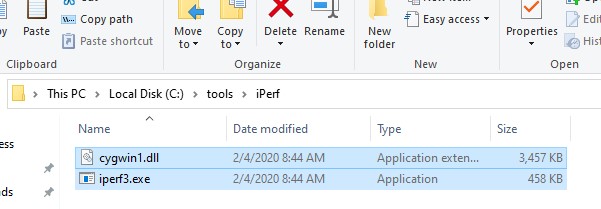
There are several iPerf GUI implementations for Windows. For case, Iperf3-Cygwin-GUI or jperf.
The jperf is written on Coffee (in order to run jperf, the Coffee VM must be installed on the figurer). In addition to graphical form for the CLI interface, Jperf tin can build graphs bandwidth charts of the communication channel in real fourth dimension.
To use it, just specify the iPerf server address and run the scan.
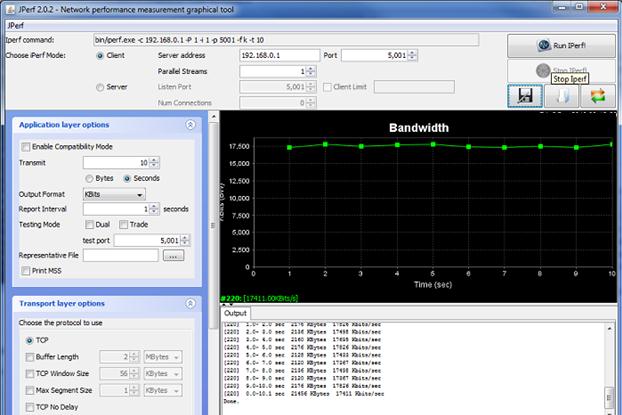
In that location is a separate iPerfAutomate module in the PowerShell Script Gallery that can be used to get network performance metrics from your PowerShell scripts. You can install the module with the command: Install-Module -Name iPerfAutomate
Installing iPerf on CentOS Linux
In CentOS 8, the iperf3 package is included in the AppStream base of operations repository (in CentOS seven you lot can discover iperf3 in the EPEL repo). You lot can install it with the dnf (yum) control:
# dnf install iperf3
On Debian/Ubuntu distros you tin install the iperf3 with the command:
sudo apt install iperf3
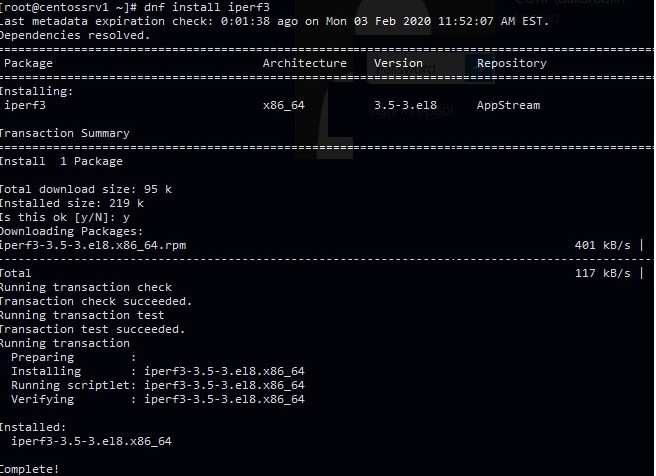
If you want to use your Linux instance as the iperf3 server, you demand to open up the TCP/UDP ports 5201 in firewalld (iptables):
# firewall-cmd --permanent --add-port=5201/udp
# firewall-cmd --permanent --add-port=5201/tcp
# firewall-cmd --reload
Using iPerf Command to Measure Network Speed/Bandwidth
Allow's look at a few examples of using iPerf to test network throughput. In this example, nosotros will use a Linux CentOS host equally the iPerf server. Run the iPerf3 tool in server mode:
# iperf3 –s
The iPerf server is running, information technology is waiting for connections on the 5201 TCP port.
Server listening on 5201.
Hint. iPerf arguments are case sensitive!

Depending on the firewall settings between the client and the server, you tin can change the listening port using the statement -p [port_number]. You can run the iPerf server with a big TCP window size and on a different TCP port. Utilize the control:
# iperf3 -southward -w 32768 –p 5200
- -w 32768 – prepare TCP windows size to 32 kB (by default information technology is about 8 kB)
- –p 5200 – the port on which iPerf is waiting for connections (I remind y'all that iperf2 listens by default on port 5001 and the iperf3 on 5201).
I am using a estimator with Windows 10 installed as an iPerf client. Run the command prompt and become to the directory with the iPerf executable:
cd c:\tools\iperf
In order to run a network bandwidth test from the client, specify the iPerf server address (or DNS name):
iperf3.exe -c 192.168.1.200
If you started the iPerf server with an increased TCP window size, you tin utilize the post-obit command to go the maximum network load:
iperf3.exe -c 192.168.1.200 -P eight -t 30 -w 32768
- -c 192.168.1.200 – IP address of the iPerf server;
- -w 32768 – increase the TCP window size;
- -t xxx – is the fourth dimension in seconds for the test to be washed (past default, it is ten seconds);
- -P 8 – is the number of parallel threads (streams) to get the maximum channel load;
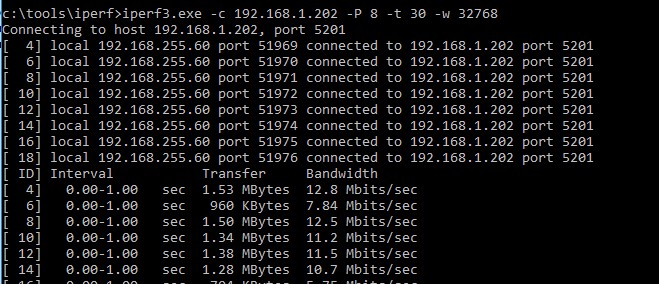
In my example, the test lasted 30 seconds. In the terminal written report, we are interested in the values of the Bandwidth column listed in the terminal [SUM] line. In this case the average network bandwidth betwixt 2 hosts is 85.9 Mbit/s. 307 MB of data was transferred (Transfer cavalcade) with the symmetric speed (sender=receiver).
Using the -f statement, yous can alter the speed format ($.25, kilobits or megabits). In the continuous tests, when y'all have to estimate the performance during several minutes (hours), you can set the flow of fourth dimension to display the intermediate results using the –i option.

You can run iPerf in reverse mode (the server sends data, and the client accepts). User the –R option on the client for this.
By default, the utility generates TCP traffic, if you need to check your network bandwidth for UDP packets, yous must employ the –u option. In this case, yous should start the iPerf server with the command: iperf3 -s –u).
If y'all need to examination your Cyberspace service provider bandwidth, y'all tin can apply one of the public iPerf servers (iPerf public host listing is available here):
iperf3 -c iperf.scottlinux.com
If you demand to measure the maximum network speed in both directions (in a duplex way), use the –d option on the client:
iperf3.exe -c IP -P 8 -t xxx -due west 32768 –d

During the network examination using iPerf, you can monitor your network connection throughput chart through the Task Director.
Information technology is important to note that, during the test, iPerf uses all available bandwidth of the communication aqueduct between the customer and server, which tin can negatively bear upon productive apps and users.
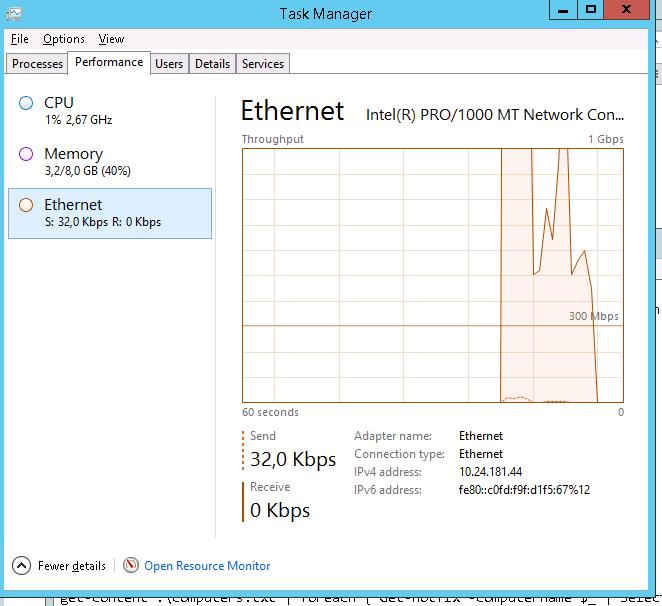
You can display the full listing of the options as follows:
iperf3 –help
Iperf is an like shooting fish in a barrel-to-employ and user-friendly network utility that helps you to measure out network connection performance and maximum data transfer speed between two devices.
Source: http://woshub.com/testing-network-bandwidth-using-iperf/
Posted by: hatcherdeconsenry.blogspot.com

0 Response to "How To Install Iperf3 On Windows"
Post a Comment